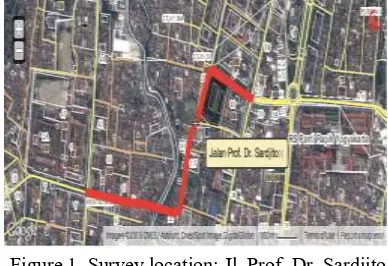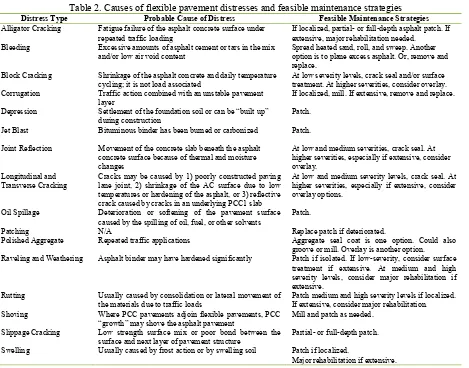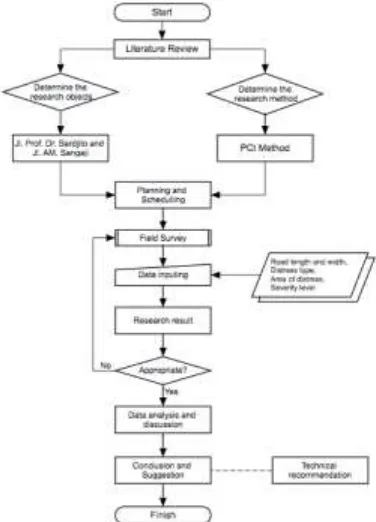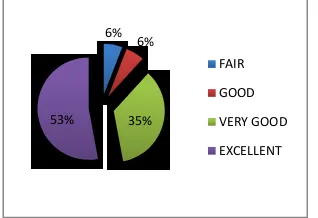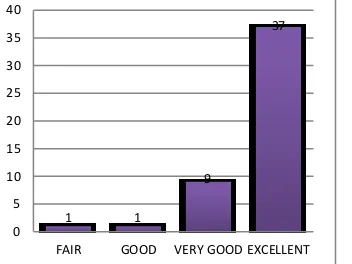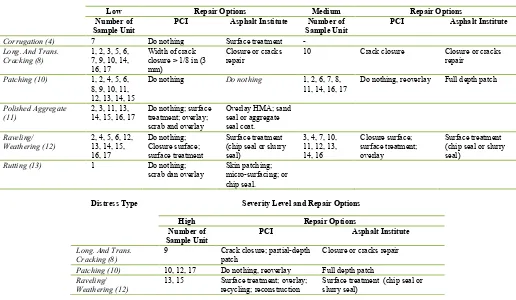ISSN: 1907-5995 335
Road Maintenance Management Using Pavement Condition
Index (PCI) Survey
Tisara Sita
Balai Besar Pelaksanaan Jalan Nasional VII, Direktorat Jenderal Bina Marga, Kementerian Pekerjaan Umum dan Perumahan Rakyat
Korespondensi: [email protected]
ABSTRAK
Manajemen pemeliharaan jalan merupakan hal yang sangat penting dalam pengelolaan jalan raya. Jl. Prof. Dr. Sardjito dan Jl. AM. Sangaji yang telah dilalui oleh volume lalu lintas membutuhkan pemeliharaan agar memenuhi umur desain rencana dan mencegah kondisi yang menjadi parah. Oleh karena itu, tujuan dari penelitian ini adalah untuk menilai kondisi perkerasan sehingga jalan dapat berfungsi lebih optimal. Penelitian ini secara visual diselesaikan dengan menggunakan Metode Pavement Condition Index (PCI). Metode ini dimulai dengan membagi jalan menjadi beberapa unit panjang, yaitu 30 m untuk setiap unit sampel. Kemudian, masing-masing unit sampel diamati, dievaluasi, dan dianalisis untuk dapat diidentifikasi tipe kerusakannya dan tingkat keparahannya untuk didapatkan nilai rating PCI pada ruas jalan tersebut. Hasil penelitian menunjukkan bahwa tipe kerusakan yang terjadi pada ruas jalan tersebut antara lain corrugation/kerut, longitudinal and transverse cracking/retak memanjang dan melintang, patching/tambalan, polished aggregate, raveling, dan potholes/lubang. Tipe kerusakan yang paling sering terjadi adalah longitudinal and transverse cracking/retak memanjang dan melintang, patching/tambalan, dan raveling dengan tingkat keparahan rendah. Berdasarkan analisis dengan metode PCI untuk kedua ruas jalan tersebut didapatkan kondisi excellent, oleh karena itu tindakan yang disarankan adalah pemeliharaan rutin agar dapat memperpanjang umur dari perkerasan pada ruas jalan tersebut. Pemilihan jenis perbaikan jalan dibandingkan antara Metode PCI dan Metode Asphalt Institute.
Kata kunci: Pavement Condition Index, manajemen pemeliharaan jalan
ABSTRACT
Road maintenance management is a very important issue in the highway management. Existing roads infrastructure on Jl. Prof. Dr. Sardjito and Jl. AM. Sangaji that has been passed by the volume of traffic requires maintenance to prevent severe condition as predicted in design life. Therefore, the objective of this study is to appraise a survey pavement condition method so that the road can be functional more optimal. This study was visually completed by using Pavement Condition Index (PCI) method. It was started by dividing the road into several units length in 30 m for each unit sample. Then, each of the sample unit was observed, evaluate, and analyze to identify the distress type and severity level in order to obtain PCI rating value of the pavement condition. The result of the study showed that the distress types in this research included the corrugation, longitudinal and transverse cracking, patching, polished aggregate, raveling, and potholes. The most distresses that usually occur are longitudinal and transverse cracking, patching and raveling with low severity. From the analysis of PCI method, the rating for both road conditions is excellent; therefore, the suggestion that can be given for those sample roads is preventive maintenance to extend a pavement's life. The road repair options are compared between PCI method by US Army and Asphalt Institute.
Keyword: Pavement Condition Index, road maintenance
1. INTRODUCTION
ReTII November 2018 : 335 – 344
Roads in Sleman and Yogyakarta will be the focus of this study, particularly Jl. Prof. Dr Sardjito (Mirota Kampus intersection to SMK 2 Yogyakarta intersection) and Jl. AM. Sangaji (SMK 2 Yogyakarta intersection to the Tugu Yogyakarta intersection), it can be seen in Figure 1 and Figure 2. The volume of traffic is fairly high at this location, especially at the intersection of Tugu as one of the tourist spots and a connecting road to Jl. Malioboro. Moreover at Jl. Prof. Dr Sardjito and Jl. AM. Sangaji is a connector road to the Gadjah Mada University and to various important locations in the city of Yogyakarta. Pavement condition surveys give an indication of the serviceability of the road pavements and also the physical condition of the assets. It is referred to as the collection of data to determine the ride quality and structural integrity of a road segment. They are based on observations by surveyors as well as measurements of pavement roughness, surface distress, skid resistance, deflection, among others. Condition ratings may be done manually or through automated means. The choice of whether automated or manual depends on an agency’s priorities and its available resources. The condition rating for a particular section is chosen from a scale, which may range from 0 to 100, 0 to 5 or even 0 to 99. Damage appears slowly at first, and then gradually accelerates, accumulating to become visible as structural distress and tangible as ride quality reduced. If distress is observed and corrected in a timely manner, low cost strategies will restore the road to nearly its original condition. However, if early treatment is neglected or postponed, the accumulated damage will require a more costly repair treatment. Recognizing that damage accumulation and acceleration is a key to understanding the need for early, low-level, low-cost preventive maintenance treatments. The main objectives of the research are: (1) investigate and evaluate the asphalt pavement defects by using pavement condition index (PCI); and (2) estimate the maintenance options.
Figure 1. Survey location: Jl. Prof. Dr. Sardjito Figure 2. Survey location: Jl. AM. Sangaji
Pavement Condition Index (PCI)
Pavement Condition Index (PCI) is a numerical rating of the pavement condition that ranges from 0 to 100 with 0 being the worst possible condition and 100 being the best possible condition (ASTM D6433 – 07, 1999). Pavement Condition Index is the most precise index in many pavement evaluation studies. PCI incorporates data from 19 different kinds of pavement distresses as well as their severity and quantity. Furthermore, it gives an insight to the causes of distresses and the relation between pavement deterioration and climatic and/or loading conditions. Therefore, it provides an index of the pavement’s structural integrity, as well as surface operational condition. PCI index is extensively used in pavement condition surveys for airfield pavement, roads and parking lots and has gained popularity among the pavement experts (Zultuom, 2011). Federal Aviation Administration (F.A.A.), U.S. Air Force, American Public Works Association (APWA) and many other agencies worldwide accept this method for pavement condition assessment. More details on PCI method are available in ASTM D6433 – 07 (1999): Standard Practice for Roads and Parking Lots Pavement Condition Index Surveys. PCI is the only pavement-rating index that has gained an ASTM standard designation.
decision to keep all the sections above this point. A sample of deterioration model and rate of changes in PCI during years was also published for the same case study (Moazami et al., 2011).
Figure 3. Numerical representation of PCI and pavement quality condition
The PCI is normally conducted annually in order to evaluate changes that occur in a road network system. It is a subjective method of evaluation based on inspection and observation. The PCI is also an informative tool that shows the current condition of the road network and its deterioration over time as illustrated in Figure 4. Some uses and benefits of PCI include, identifying the need for immediate maintenance and rehabilitation (M & R) (Galehouse et. Al. 2003) of roads; developing a road network preventive maintenance strategies and budgets; and for evaluating pavement materials and designs (see Figure 5).
Figure 4. Pavement condition vs age (Source: Road Millage, August 7, 2012)
Figure 5. Benefits of M & R as a function of pavement condition (PCI)
(Source: Galehouse et. al. 2003)
Road Maintenance Strategies
The PCI procedure was developed by the Colorado Division of Aeronautics (2011) to provide a numerical indication of overall pavement condition. During a PCI survey, visible signs of deterioration within a selected sample unit are recorded and analyzed. Distress type, severity, and quantity are all identified and recorded. This information is then used to develop a composite index (PCI number) that represents the overall condition of the pavement in numerical terms, ranging from 0 (failed) to 100 (excellent). In general terms, pavements above a PCI of 65 that are not exhibiting significant load-related distress will benefit from preventive maintenance actions, such as crack sealing and surface treatments. Pavements with a PCI of 40 to 65 may require major rehabilitation, such as an overlay. Often, when the PCI is less than 40, reconstruction is the only viable alternative due to the substantial damage to the pavement structure. This concept, along with the PCI rating scale, is illustrated in Figure 6.
ReTII November 2018 : 335 – 344
The types of distress identified during the PCI inspection provide insight into the cause of pavement deterioration. PCI distress types are characterized as load-related, climate/durability-related, and other (distress types that cannot be attributed solely to load or climate/durability). Each of the distress types and their associated primary cause of distress are identified in Table 1. By knowing the causes of the pavement deterioration, more appropriate repair and rehabilitation alternatives can be identified. Table 2 provides additional information on the likely cause of each distress type and feasible maintenance strategies for addressing each distress type for AC pavements.
Table 1. Distress types and primary distress categories for AC pavements Pavement Distress Category
Load-Related Climate-Related Other Fatigue
Table 2. Causes of flexible pavement distresses and feasible maintenance strategies
Type of Repair Options
According to Shahin et al. (2005) the PCI method provides repair option according to the distress type and the severity level shown in Table 3. In addition to PCI method, there are so many road maintenance methods such as Asphalt Institute method, AASHTO method, and Austroad method. Other method to be compared to PCI method in this research is Asphalt Institute–MS 16 with the type of repair options shown in Table 4.
Distress Type Probable Cause of Distress Feasible Maintenance Strategies
Alligator Cracking Fatigue failure of the asphalt concrete surface under repeated traffic loading
If localized, partial- or full-depth asphalt patch. If extensive, major rehabilitation needed.
Bleeding Excessive amounts of asphalt cement or tars in the mix and/or low air void content
Spread heated sand, roll, and sweep. Another option is to plane excess asphalt. Or, remove and replace.
Block Cracking Shrinkage of the asphalt concrete and daily temperature cycling; it is not load associated
At low severity levels, crack seal and/or surface treatment. At higher severities, consider overlay. Corrugation Traffic action combined with an unstable pavement
layer
If localized, mill. If extensive, remove and replace.
Depression Settlement of the foundation soil or can be “built up” during construction
Patch.
Jet Blast Bituminous binder has been burned or carbonized Patch.
Joint Reflection Movement of the concrete slab beneath the asphalt concrete surface because of thermal and moisture changes
At low and medium severities, crack seal. At higher severities, especially if extensive, consider overlay.
Longitudinal and Transverse Cracking
Cracks may be caused by 1) poorly constructed paving lane joint, 2) shrinkage of the AC surface due to low temperatures or hardening of the asphalt, or 3) reflective crack caused by cracks in an underlying PCC1 slab
At low and medium severity levels, crack seal. At higher severities, especially if extensive, consider overlay options.
Oil Spillage Deterioration or softening of the pavement surface caused by the spilling of oil, fuel, or other solvents
Patch.
Patching N/A Replace patch if deteriorated.
Polished Aggregate Repeated traffic applications Aggregate seal coat is one option. Could also groove or mill. Overlay is another option. Raveling and Weathering Asphalt binder may have hardened significantly Patch if isolated. If low-severity, consider surface
treatment if extensive. At medium and high severity levels, consider major rehabilitation if extensive.
Rutting Usually caused by consolidation or lateral movement of the materials due to traffic loads
Patch medium and high severity levels if localized. If extensive, consider major rehabilitation. Shoving Where PCC pavements adjoin flexible pavements, PCC
“growth” may shove the asphalt pavement Mill and patch as needed.
Slippage Cracking Low strength surface mix or poor bond between the surface and next layer of pavement structure
Partial- or full-depth patch.
Swelling Usually caused by frost action or by swelling soil Patch if localized.
Table 3. Type of repair options based on PCI method [9]
No. Distress Type Type of Repair Options
Low (L) Medium (M) High (H)
1 Alligator cracking Do nothing; overlay Partial or full depth patch; overlay; reconstruction
Partial or full depth patch; overlay; reconstruction 2 Bleeding Do nothing Spreading sand or aggregate Spreading sand or aggregate 3 Block cracking crack > 1/8 in (3
4 Corrugation Do nothing Reconstruction Reconstruction
5 Depression Do nothing Leveling; partial or full-depth patching;
Leveling; partial or full-depth patching; 6 Jet Blast
7 Joint reflection cracking Crack closure > 1/in (3 mm)
Crack closure; partial-depth patch
partial-depth patch, reconstruction, joint 8 Longitudinal and Transverse
Cracking
Width of crack closure > 1/8 in (3 mm);
Crack closure Crack closure; partial-depth patch
9 Oil Spillage
10 Patching and utility cut patching Do nothing Do nothing, reoverlay Do nothing, reoverlay 11 Polished aggregate Do nothing; surface
treatment; overlay; scrab 12 Raveling and Weathering Do nothing;
Closure surface; surface
Levelling or partial; or full depth patch; scrab and overlay
Levelling or partial; or full depth patch; scrab and overlay
14 Shoving Do nothing; scrab scrab; partial- or full -depth patch.
scrab; partial- or full -depth patch.
15 Slippage cracking Do nothing; partial-depth patch.
Partial-depth patch. Partial-depth patch.
16 Swelling Do nothing Do nothing; reconstruction reconstruction
17 Potholes Do nothing; partial or full-depth patch
partial or full-depth patch full-depth patch
Table 4. Type of repair based on Asphalt Institute (MS-16) Method
No. Distress Type Repair Option
Low (L) Medium (M) High (H)
1 Alligator cracking Slurry seal; surface treatment or skin patching.
Full-strength patch. Full-strength patch.
2 Bleeding Seal coat. Spreading Hot sand; or spreading
hot rock screening.
Spreading Hot sand; or spreading hot rock screening. 3 Block cracking Surface seal. Asphalt emulsion’slurry; surface
treatment or slurry seal; overlay.
Asphalt emulsion’slurry;
surface treatment or slurry seal; overlay.
4 Corrugation Surface treatment Levelling; milling; overlay Full-depth patch. 5 Settlement or grade
depressions
Surface treatment; micro-surfacing.
Skin patch or full-depth patch; Skin patch or full-depth patch;
7 Reflective cracks Surface treatment (slurry seal or chip seal), seal cracks.
Cleaning and crack closure Filling with asphalt emulsion slurry or HMA finely graded
8 Linear cracking Closure or cracks repair Closure or cracks repair Closure or cracks repair 9 Utility cut and/or patch
failure
Do nothing Full depth patch Full depth patch
10 Polished aggregate Overlay HMA; sand seal or aggregate seal coat.
Overlay HMA; sand seal or aggregate seal coat.
Overlay HMA; sand seal or aggregate seal coat. 11 Potholes Cleaning and holes closure
with cold mix asphalt.
full-depth patch. full-depth patch.
12 Rutting Skin patching;
micro-surfacing; or chip seal.
Full depth patch or overlay HMA.
Reconstruction
13 Shoving Surface treatment Levelling; scrabing; overlay. Full-depth patch. 14 Slippage cracking Replacement of the surface
patches
Replacement of the surface patches
Replacement of the surface patches
15 Swell Full-depth patch. Full-depth patch. Full-depth patch.
16 Weathering and raveling Surface treatment (chip seal or slurry seal)
Surface treatment (chip seal or slurry seal)
Surface treatment (chip seal or slurry seal)
ReTII November 2018 : 335 – 344
2. METHODOLOGY
Quantitative research approach is chosen instead over qualitative research. The used data is primary data, and after that the available data is being analyzed. The methodology flow chart for this research can be seen in Figure 7. The data analysis flowchart can be seen in Figure 7.
1. Proposing The Road Maintenance Strategy
The road maintenance strategy is proposed after the road condition rating is obtained. The road maintenance strategy is selected in accordance with Figure 6. Road maintenance priority is determined based on the lowest condition of the road and the highest AADT.
2. Determine The Road Repair Options
Maintenance is an essential practice in providing for the long-term performance and the esthetic appearance of an asphalt pavement. The purpose of pavement maintenance is to correct deficiencies caused by distresses and to protect the pavement from further damage. After road maintenance obtained, then repair options is determined based on the distress type and the severity level that occurs in accordance with Tables 2, 3, and 4.
Figure 7. Research methodology flowchart
3. RESEARCH RESULT AND ANALYSIS
PCI Calculation Results
PCI calculation results for each sample unit on Jl. Prof. Dr. Sardjito are on Table 5.2, the number of distress types in each sample unit can be seen on Figure 8, while the PCI Rating for Jl. Prof. Dr Sardjito can be found on Figure 9.
Table 5. PCI calculation results of each sample unit on Jl. Prof. Dr. Sardjito
Sample Unit PCI Rating Sample Unit PCI Rating Sample Unit PCI Rating
Sample Unit 1 100 EXCELLENT Sample Unit 12 100 EXCELLENT Sample Unit 23 100 EXCELLENT
Sample Unit 2 100 EXCELLENT Sample Unit 13 100 EXCELLENT Sample Unit 24 100 EXCELLENT
Sample Unit 3 100 EXCELLENT Sample Unit 14 100 EXCELLENT Sample Unit 25 100 EXCELLENT
Sample Unit 4 100 EXCELLENT Sample Unit 15 100 EXCELLENT Sample Unit 26 91 EXCELLENT
Sample Unit 5 100 EXCELLENT Sample Unit 16 100 EXCELLENT Sample Unit 27 97 EXCELLENT
Sample Unit 6 100 EXCELLENT Sample Unit 17 100 EXCELLENT Sample Unit 28 100 EXCELLENT
Sample Unit 7 100 EXCELLENT Sample Unit 18 100 EXCELLENT Sample Unit 29 100 EXCELLENT
Sample Unit 8 100 EXCELLENT Sample Unit 19 100 EXCELLENT Sample Unit 30 100 EXCELLENT
Sample Unit 9 100 EXCELLENT Sample Unit 20 75 VERY GOOD Sample Unit 31 100 EXCELLENT
Sample Unit 10 95 EXCELLENT Sample Unit 21 72 VERY GOOD
Figure 8. Number of Distress Types in each sample unit on Jl. Prof. Dr. Sardjito
Figure 9. PCI Ratings on Jl. Prof. Dr. Sardjito
PCI calculation results for each sample unit on Jl. AM. Sangaji are on Table 6, the number of distress types in each sample unit can be seen on Figure 10, while the PCI Rating for Jl. AM. Sangaji can be found on Figure 11.
Table 6. PCI calculation results of each sample unit on Jl. AM. Sangaji
Sample Unit PCI Rating Sample Unit PCI Rating
Sample Unit 1 77 VERY GOOD Sample Unit 10 80 VERY GOOD
Sample Unit 2 89 EXCELLENT Sample Unit 11 90 EXCELLENT
Sample Unit 3 87 EXCELLENT Sample Unit 12 78 VERY GOOD
Sample Unit 4 90 EXCELLENT Sample Unit 13 90 EXCELLENT
Sample Unit 5 86 EXCELLENT Sample Unit 14 54 FAIR
Sample Unit 6 84 VERY GOOD Sample Unit 15 79 VERY GOOD
Sample Unit 7 87 EXCELLENT Sample Unit 16 79 VERY GOOD
Sample Unit 8 87 EXCELLENT Sample Unit 17 70 GOOD
Sample Unit 9 86 EXCELLENT Average 82 VERY GOOD
Figure 10. Number of Distress Types in each sample unit on Jl. Prof. Dr. Sardjito
Figure 11. PCI Ratings on Jl. AM. Sangaji 0
1 2 3 4 5
1 2 3 4 5 6 7 8 9 10 11 12 13 14 15 16 17 18 19 20 21 22 23 24 25 26 27 28 29 30 31
N
u
m
b
e
r
o
f
D
is
tr
e
ss
Sample Unit
90% 10%
EXCELLENT
VERY GOOD
0 1 2 3 4 5
1 2 3 4 5 6 7 8 9 10 11 12 13 14 15 16 17
N
um
be
r
o
f
D
ist
re
ss
Sample Unit
6% 6%
35% 53%
FAIR
GOOD
VERY GOOD
ReTII November 2018 : 335 – 344
The road condition rating based on PCI calculation for both roads, Jl. Prof. Dr. Sardjito and Jl. AM. Sangaji can be seen on Figure 12, while the PCI distribution value for both roads can be found on Figure 13.
Figure12. Road condition rating based on PCI calculation on Jl. Prof. Dr. Sardjito and Jl. AM. Sangaji
Figure13. PCI distribution value on Jl. Prof. Dr. Sardjito and Jl. AM. Sangaji
Road Maintenance Strategies
After determine the road maintenance priority, which presented on Table 7, road maintenance strategies based on the PCI method is selected based on Figure 6. Pavement with PCI values above 65, generally do not show significant distress level (due to load) and can be treated with preventive maintenance such as the closure of cracks and surface maintenance. Pavement with 40-65 PCI values needs rehabilitation, such as overlay. If PCI value is less than 40, then the most viable alternative maintenance to be applied is the reconstruction because the damage that occurs is structural damage. Road maintenance strategy based on the value of the PCI is showed in Table 8.
Table 7. Road maintenance priority based on PCI method
No. Link PCI Rating
1 Jl. AM. Sangaji 82 VERY GOOD
2 Jl. Prof. Dr. Sardjito 97 EXCELLENT
Table 8. Road maintenance strategies based on PCI method
No. Link PCI Rating Maintenance Strategy
1 Jl. AM. Sangaji 82 VERY GOOD Preventive Maintenance 2 Jl. Prof. Dr. Sardjito 97 EXCELLENT Preventive Maintenance
The importance of choosing the right maintenance strategy will have an impact on the resources to be spent, such as costs, labour, tools, and time. The precision maintenance strategy needs to be taken with a rational basis. PCI illustrates the maintenance strategy selection related to PCI value and time as shown in Figure 14.
Figure 14. PCI rating vs dan Time (Colorado State University, 2013) 1 1
9
37
0 5 10 15 20 25 30 35 40
FAIR GOOD VERY GOOD EXCELLENT
0 20 40
54.5 58.5 62.5 66.5 70 73.5 77.5 81.5 85.5 89.5 93.5 98
N
Umb
e
r
o
f
S
a
mp
le
Uni
t
Pavement in fair condition needs to be rehabilitated immediately in order not to worsen the condition. Figure 14 illustrates that if it is assumed that pavement design life is 10 years of service, so the required time for pavement of the fair condition becomes failed only takes 1.5 years. Therefore if the road PCI value is 65, it must be rehabilitated, such as thin overlay or patching. If the pavement becomes failed due to late rehabilitation, it takes 4 to 5 times the cost of rehabilitation.
Road Repair Options
As the road priority maintenance has been completed obtained, the road repair options have to be determined, so the fieldwork can be done immediately. Repairs must be done immediately to prevent the worsen damage, so that the repair options chosen is still appropriate to the type of distress, the severity level, and the quantity of the damage. This is because the damage is affected by time, load, and weather; so the longer it is not repaired, the worse the type, the severity level, and the quantity of damage. Road repair options based on the method of PCI and Asphalt Institute MS-16 can be seen in Table 9 and Table 10. PCI method by The Unified Facilities Criteria (2004) does not consist the distress type as follows: railroad crossing, potholes, bumps and sags, edge cracking, and lane/shoulder drop off. The repair option of pothole in Table 9 is determined by Shahin et al. (2005).
Table 9. Road repair options based on PCI method and Asphalt Institute Method on Jl. Prof. Dr. Sardjito
Distress Type Severity Level and Repair Options
Low Repair Options
Surface treatment (chip seal or slurry seal)
Pothole (17)* 26 Do nothing; partial atau full-depth patch Cleaning and holes closure with cold mix asphalt.
Table 10. Road repair options based on PCI method and Asphalt Institute Method on Jl. AM. Sangaji
Distress Type Severity Level and Repair Options Severity Level and Repair Options
Low Repair Options Medium Repair Options
Number of Sample Unit
PCI Asphalt Institute Number of Sample Unit
PCI Asphalt Institute
Corrugation (4) 7 Do nothing Surface treatment -
Long. And Trans.
10 Crack closure Closure or cracks repair
Do nothing, reoverlay Full depth patch
Polished Aggregate
Distress Type Severity Level and Repair Options
High Repair Options
9 Crack closure; partial-depth patch
Closure or cracks repair
Patching (10) 10, 12, 17 Do nothing, reoverlay Full depth patch
Raveling/ Weathering (12)
13, 15 Surface treatment; overlay; recycling; reconstruction
ReTII November 2018 : 335 – 344
4. CONCLUSION
After conducted an analysis and discussion of the results using the PCI method, the conclusions can be explained as follows.
a. The PCI value of Jl. Prof. Dr. Sardjito is 97, while on Jl. AM. Sangaji is 82;
b. The road condition rating of Jl. Prof. Dr. Sardjito is “Execllent”, while on Jl. AM. Sangaji is “Very Good”;
c. The road maintenance of Jl. AM. Sangaji is higher priority than Jl. Prof. Dr. Sardjito. Both of Jl. Prof. Dr. Sardjito, and Jl. AM. Sangaji only needs preventive maintenance;
d. Both of Jl. Prof. Dr. Sardjito, and Jl. AM. Sangaji only needs preventive maintenance. Effective maintenance can extend a pavement's life. Crack sealing and surface treatments can reduce in aging of asphalt pavement. The provision of necessary equipment for maintenance work in order to raise the level of efficiency of maintenance;
e. PCI method by The Unified Facilities Criteria (2004) should consist the distress type and also the repair options, as follows: railroad crossing, potholes, bumps and sags, edge cracking, and lane/shoulder drop off;
f. Axle-load of vehicles must be controlled for preserving the pavement condition;
g. For Public Works Service of Yogyakarta and Sleman, periodic inspection is necessary to provide current and useful evaluation data. It is recommended that ratings be updated every year. The survey should be conducted in a more thorough and conducted by surveyors who have knowledge and high sense of engineering in assessing the distress. Each surveyor should be trained under the supervision of engineers who have experience in advance to ensure the reliability of data to be obtained; and
h. It is necessary to study the application of the preventive maintenance management then compared with corrective maintenance or reactive maintenance, which commonly implemented in Indonesia.
REFERENCES
[1] Aeronautics, C. D. (2011). Pavement Evaluation and Pavement Management System Update. Retrieved January 02, 2014, from www.codot.gov
[2] Applied Pavement Technology, Inc. (2010). Pavement Condition Summary, Colorado Springs Airport. Report. [3] ASTM International. (2007). Standard Practice for Roads and Parking Lots Pavement Condition Index Surveys.
West Conshohocken, United States: ASTM International.
[4] Civil Aviation Safety Authority, Australian Governmentent. (2011). Strength Rating of Aerodrome Pavements. Advisory Circular.
[5] Federal Aviation Administration. (2014). Airport Pavement Management Program (PMP). U.S. Department of Transportation. Advisory Circular.
[6] Federal Aviation Administration. (2014). Guidelines and Procedures for Maintenance of Airport Pavements. U.S. Department of Transportation. Washington, DC: Advisory Circular.
[7] Moazami, D. e. (2011, June 18). The Use of Analytical Hierarchy Process in Priority Rating of Pavement Maintenance. Scientific Research and Essays Vol. 6 , 2447-2456.
[8] Rosalina, D. (2013). Sistem Manajemen Pemeliharaan Perkerasan Jalan dengan Metode Manual Pemeliharaan Rutin Jalan untuk Jalan Nasional dan Propinsi Tahun 2011. Yogyakarta: MSTT, Universitas Gadjah Mada. [9] Shahin, M. (1994). Pavement Managements for Airports, Roads, and Parking Lots (Vol. Fourth Edition).
Massachusetts: Chapman and Hall, Kluwer Academic Publisher.
[10] The Asphalt Institute. (2001). Asphalt in Pavement Maintenance. Manual Series, Kentucky.
[11] U.S. Army Corps of Engineers. (2004). Airfield Pavement Condition Survey Procedures Pavements. Department of The Army and The Air Force. Washington, DC: U.S. Air Force Civil Engineering Support Agency (AFCESA/ CESC).
